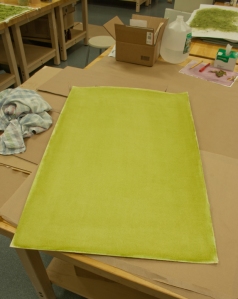For my own notes. What follows is tedious paper + anthotype research.
I really didn't expect this to do what it did.
The anthotype emulsion, for what ever reason, is very sensitive to the paper it is applied to. The color changes in response to pH and, because the color you start out with is the color you end up with, coating issues related to internal sizing of paper are magnified. Two papers that I have tried, Utrecht drawing and the washi paper from Kochi didn't have enough size which created a problem with applying the emulsion evenly. It would soak through the paper before it could be spread out. Noticing that spilled emulsion would dry down beautifully on plastic spoons and varnished table surfaces, I decided to try something the exact opposite of an unsized paper, Yupo. This polystyrene sheet absorbs nothing. You are basically pushing around a liquid until it dries. I was hoping it would dry dark like the spilled emulsion or the emulsion left on containers and spoons.
The Yupo was extremely frustrating. It separated the larger pieces of rose pigment that had made it through the coarse filter from the liquid creating a speckled look. Where there was lots of homogenous liquid, it appeared uneven and lighter than I had hoped.
Frustrated with my attempts to let gravity pull the liquid over the surface of the Yupo, I went back to my dorm for dinner. I came back about two hours later to a lovely surprise. The emulsion had dried down darker. While it is still uneven and speckled, I am happy with the degree of color and will try once more with the Yupo, filtering the liquid through a finer mesh and perhaps applying the emulsion with a spray bottle.
A bit boring but a wonderful discovery to come back to after a day of limited success. It reminds me of the story of Marie and Pierre Curie returning to their lab at night following dinner to witness the beautiful glowing color of the room (from their research into radiation).


























